| کد مقاله | کد نشریه | سال انتشار | مقاله انگلیسی | نسخه تمام متن |
|---|---|---|---|---|
| 6475076 | 1424968 | 2017 | 7 صفحه PDF | دانلود رایگان |
- The CO concentration decreased but that of H2 increased with increasing blend ratio.
- The carbon conversion efficiencies were higher than 99.8% for all blend ratios.
- The cold gas efficiencies ranged between 82.8% and 88.1%.
- 10% of biomass blend ratio was the best case for the oxygen/carbon ratio of 2.51 used in this study.
Co-utilization of coal and biomass in a power plant can reduce the overall CO2 emission by partly displacing fossil-fuel combustion with near-carbon-neutral combustion of biomass. Computational fluid dynamics (CFD) modeling of co-gasification is conducted using a validated gasification model to examine the effect of biomass amount on the co-gasification process in a Shell gasifier. In the sub-models for coal and biomass char reactions, pore and bulk diffusions are considered using a user-defined function. The coal (Douglas premium coal, South Africa) and biomass (wood pellet treated from sawdust of pine and oak in South Korea) blend ratios (based on calorific value) are 0.0 (coal 100%), 0.05, 0.1, 0.15, and 0.2. The CFD model is validated using the actual operating data of the integrated gasification combined-cycle plant located in Puertollano, Spain. The CO concentration decreases but that of H2 increases with increasing blend ratio. The cold gas efficiencies range between 82.8% and 88.1%, and the carbon conversion efficiencies are higher than 99.8% for all blend ratios. These efficiencies are similar to those of coal gasification. However, blend ratios of 0.15 and 0.2 are not appropriate for co-gasification because the exit temperatures calculated for these two blend ratios are 1708 and 1621Â K, respectively, in which both are lower than the critical slag viscosity temperature (1753Â K) of the coal used in this study.
Journal: Fuel - Volume 196, 15 May 2017, Pages 371-377
